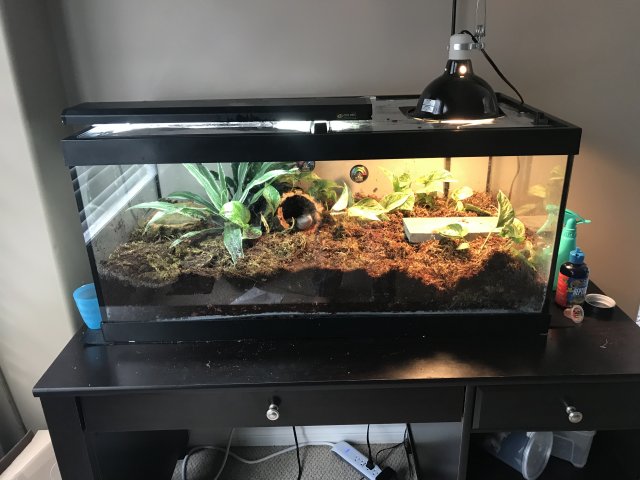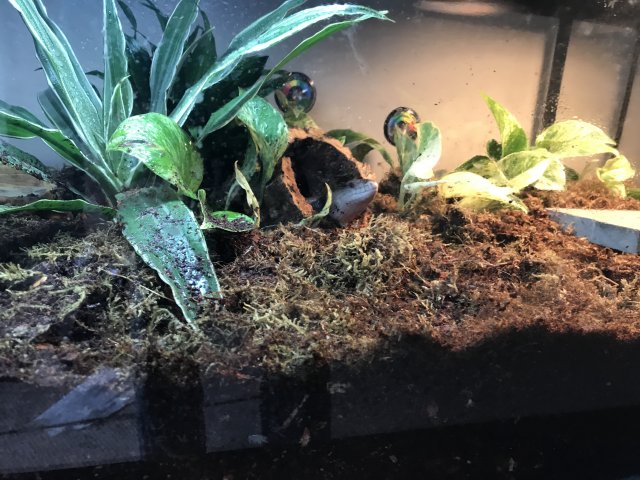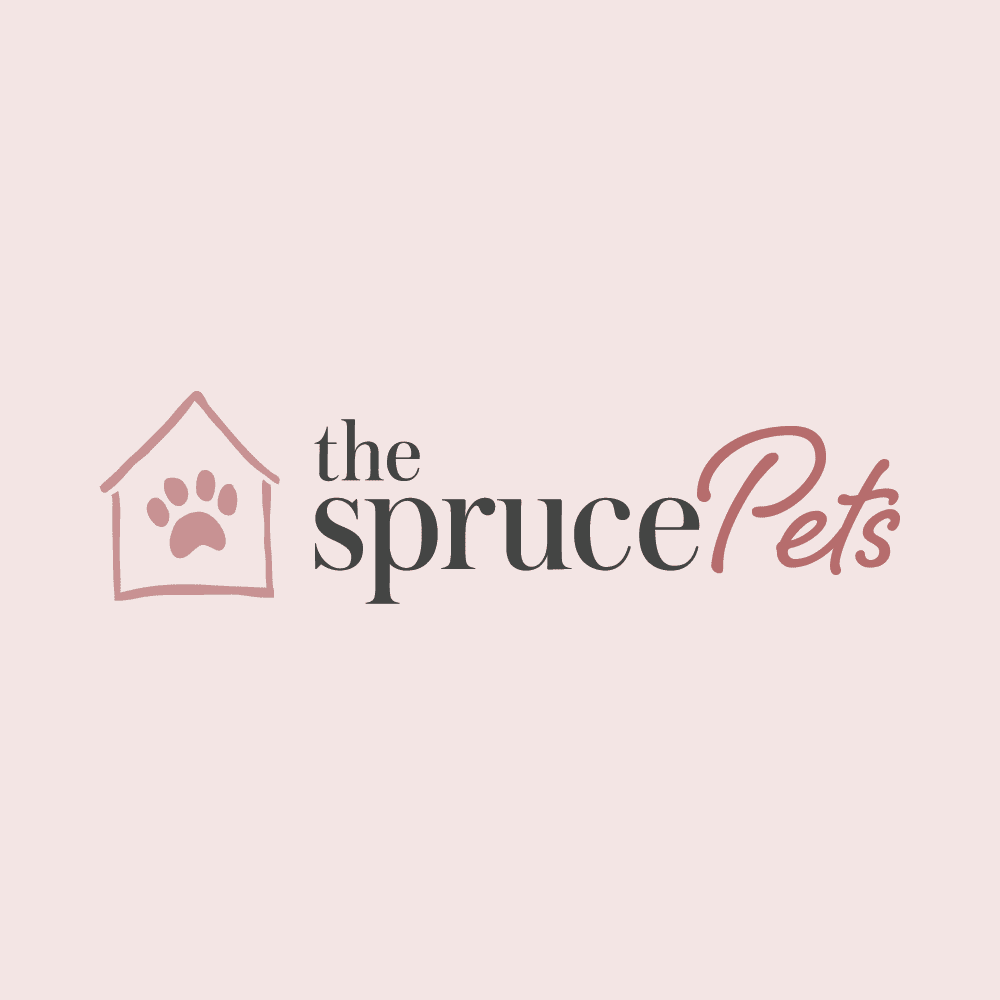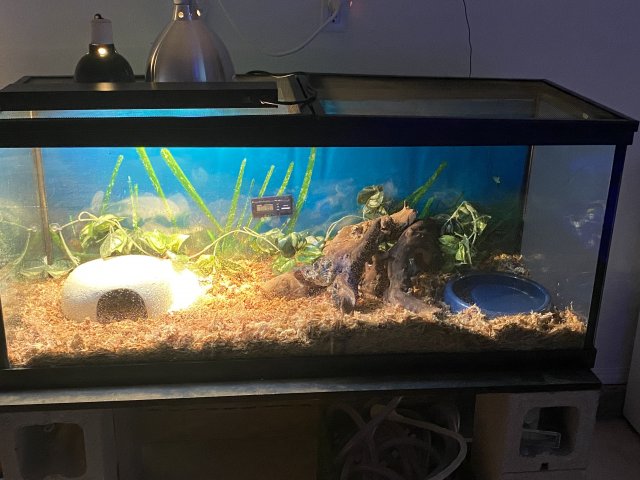Blue tongue skinks Latin name Tiliqua are great pets for beginners and advanced keepers alike. They are full of personality and very hardy two great attributes. The Blue tongue skink is the common name given to all members of the Tiliqua genus with two major different location variants: The Indonesian and New Guinea group, and the Australian group . The genus Contains the following species
Australian Species
- Tiliqua scincoides intermedia (Northern Blue Tongue Skink)
-Tiliqua scincoides scincoides (Eastern Blue Tongue Skink)
-Tiliqua occipitalis (Western Blue Tongue Skink)
-Tiliqua nigrolutea (Blotched Blue Tongue Skink)
-Tiliqua multifasciata (Centralian Blue Tongue Skink)
-Tiliqua adelaidensis (Pygmy blue Tongue Skink)
- Tiliqua rugosa (ShingleBack or BobTail Blue Tongue Skink
Indonesian and New Guinea Species
-Tiliqua gigas gigas (Classic Indonesian Blue Tongue Skink)
-Tiliqua gigas gigas (Halmahera Local)
-Tiliqua Sp (Irian Jaya Blue Tongue Skink)
-Tiliqua gigas keyensis (Kei Island Blue Tongue Skink)
-Tiliqua gigas evanescens (Merauke Blue Tongue Skink)
- Tiliqua scincoides chimaera (Tanimbar Blue Tongue Skink)
Differences
The main differences between the Australian Species and the Indonesian Species are...
-Humidity
-Body Shape
-Availability
Humidity
The Indonesian and New Guinea species require high humidity levels anywhere from 60% to 100% with 80% and above being the best for most species.
The only outlier is the halmahera who requires 80% and up with anything lower than that having the possibility for health issues. The most low humidity resistant is the Classic Indonesian Blue Tongue Skink which is able to thrive in Humidity as low as 60% but try to provide the Highest humidity possible to prevent respiratory infections.
Frequent mistings are required to maintain these levels.
The Australian species thrive in much drier environments with a humidity of 40% to 60% Misting is not required. Many Blue Tongue Skink keepers choose to give their Australian skinks a special type of hide called a humid hide which is a waterproof box filled with a humidity holding substrate, often sphagnum moss. Mist the box often. Having a humid hide aids with the shedding process helping with stuck shed which if left untreated can lead to lost toes.
Body Shape
The Indonesian species are more slender and have longer tails and bodies while the Australian species are more heavy bodied and have shorter stubbier tails
Availability
Another main difference is availability many Indonesian Species are very common for Example Halmahera, Common Indonesian and Mereuka
These species are Highly available online and in stores in the United States and Canada the main reason being they are being Exported out of Indonesia and New Guinea
which makes them much cheaper then Captive Bred Animals the average price that these species go for is 250 USD to 500 USD Depends on if they are captive bred and how old they are. The rest of the Indonesian Skinks are a bit harder to find but it is still pretty easy to track one down online but it is uncommon to find in stores.
The Australian Species are more expensive and a little harder to find due to Australia's Exporting ban. You will most likely need to talk to a breeder to get one or Purchase one online. Northern Blue Tongue Skinks are the most common Blue Tongues available in North America and typically cost 400 USD to 800 USD depending on Size. Some morphs can cost into the thousands. Northern, Eastern and Western Blue Tongues are the only species available in North America there are several centralian and Shingle back Skinks in North America but the chances of a Private collector getting one are slim to non with most specimens circulating around zoos
Size
Blue Tongue Skinks are Medium sized lizards with an average size of 16"-24" for most Australian Species and 20"-30" for the Indonesian group. Most Australian Blue Tongue skinks reach 24" but the Centralian Blue Tongue averages 16"-18" mostly due to its shorter tail. Most Indonesian Species reach a maximum size of 24"-26" with Mereukas being the outlier and reaching sizes of 30"with some getting slightly larger.
Keep in mind that the growth rate and size of your Blue Tongue Skink is largely up to you. It is your job to provide a healthy well rounded diet that best suits your animal, a diet like this will show the best results in growth.
Lighting and temperature
There is a big controversy around UVB lighting for Blue Tongue Skinks. Many people say they need it and many say they don’t. I say why risk it! I give my Blue Tongue UVB and he is doing great. If you choose to not use UVB (I highly recommend you use UVB) make sure to use supplements. As for temperature you should have an ambient temperature of 75-82°F and a basking spot around 95-100°F. Night time drops are not needed during the night heat can be added with under tank heating, ceramic heat emitters or other non light producing heat sources. I choose to let my Blue Tongue have a night time drop but I make sure the temperature never gets below the mid 60s.
Enclosure Size and Setup
Another controversial topic is Blue Tongue enclosure size. Many people say that Blue Tongue Skinks can be kept in a 40 gallon breeder aquarium long term. I think that is ridiculous, a 24” lizard in a 18” wide tank. Not only does the Blue Tongue not have enough space (In my opinion) but it is difficult to keep a proper temperature gradient in an enclosure that size. Generally the Minimum enclosure size is a 4’x2’x2’ enclosure. The nice thing about Blue Tongues is that they tend to leave plants alone so you can make really beautiful bio active enclosures. What they do tend to do is dig! So make sure to have a deeper substrate. This also helps with humidity for certain species. Since they dig, keeping them out of the drainage layer of a bioactive setup can be a challenge. To fix this you can add an egg crate layer over the screening.
Here is a picture of my Indonesian Blue Tongue Skinks enclosure. He is still young and will be moved to a much larger enclosure soon.


Blue Tongue Skinks are not arboreal; they stick to the ground and dig. Since this is the case they do not need tall enclosures or tall decorations. The only hide I give my blue tongue skink is a cork round. I have tried giving him more but he does not use them. He tends to make his own hides under the substrate.
Feeding
Blue Tongues are not picky and can eat a wide range of food.
Many people feed their Skinks canned Dog and Catfood and have great success. I choose to give my blue tongue a more natural diet of fresh greens / veggies and insects. I would recommend to use an insect and Veggie diet if you are not a breeder and your skink is solely a pet. In general it is good to follow a guideline of 10% Fruit 40% Protein and 50% Veggies and Greens for your Skink. Here is a fantastic diet chart from BlueTongueSkink.org
https://www.bluetongueskinks.org/forum/app.php/page/food-chart
Temperament and Taming
Blue Tongue Skinks are very laid back lizards that are great for handling (Except for wild caught individuals) they are one of the only reptiles that seems to enjoy human interaction. It is a good idea to socialize your Skink by taking them out regularly. I find it helps to feed your Skink outside of the enclosure. This teaches them not to expect food every time you open the cage and it also helps them have positive experiences with you and the areas outside of their cage. If your Blue Tongue Skink is wild caught, which sadly some are, the taming process will be much harder and it is unlikely you will ever get to the same level as a captive bred Skink. It will take a lot more work but it is possible to get a Wild caught Skink to the point where they will handle being around you and handling.
How do I Tell the Gender of my Skink?
This can be challenging Two ways that can be relied upon are
Brumation
Brumation is when an animal goes through a hibernating state although they sometimes wake up to briefly bask and drink. Blue Tongue Skinks brumate through the colder months during this time make sure to keep the water clean and put it where your Skink can easily access it. Sometimes your Skink might skip brumating all together but don’t try to keep them awake. Brumation generally lasts 1-4 months. Check in with your Blue Tongue every couple days when they are Brumating just to make sure they are not losing too much weight.
Australian Species
- Tiliqua scincoides intermedia (Northern Blue Tongue Skink)
-Tiliqua scincoides scincoides (Eastern Blue Tongue Skink)
-Tiliqua occipitalis (Western Blue Tongue Skink)
-Tiliqua nigrolutea (Blotched Blue Tongue Skink)
-Tiliqua multifasciata (Centralian Blue Tongue Skink)
-Tiliqua adelaidensis (Pygmy blue Tongue Skink)
- Tiliqua rugosa (ShingleBack or BobTail Blue Tongue Skink
Indonesian and New Guinea Species
-Tiliqua gigas gigas (Classic Indonesian Blue Tongue Skink)
-Tiliqua gigas gigas (Halmahera Local)
-Tiliqua Sp (Irian Jaya Blue Tongue Skink)
-Tiliqua gigas keyensis (Kei Island Blue Tongue Skink)
-Tiliqua gigas evanescens (Merauke Blue Tongue Skink)
- Tiliqua scincoides chimaera (Tanimbar Blue Tongue Skink)
Differences
The main differences between the Australian Species and the Indonesian Species are...
-Humidity
-Body Shape
-Availability
Humidity
The Indonesian and New Guinea species require high humidity levels anywhere from 60% to 100% with 80% and above being the best for most species.
The only outlier is the halmahera who requires 80% and up with anything lower than that having the possibility for health issues. The most low humidity resistant is the Classic Indonesian Blue Tongue Skink which is able to thrive in Humidity as low as 60% but try to provide the Highest humidity possible to prevent respiratory infections.
Frequent mistings are required to maintain these levels.
The Australian species thrive in much drier environments with a humidity of 40% to 60% Misting is not required. Many Blue Tongue Skink keepers choose to give their Australian skinks a special type of hide called a humid hide which is a waterproof box filled with a humidity holding substrate, often sphagnum moss. Mist the box often. Having a humid hide aids with the shedding process helping with stuck shed which if left untreated can lead to lost toes.
Body Shape
The Indonesian species are more slender and have longer tails and bodies while the Australian species are more heavy bodied and have shorter stubbier tails
Availability
Another main difference is availability many Indonesian Species are very common for Example Halmahera, Common Indonesian and Mereuka
These species are Highly available online and in stores in the United States and Canada the main reason being they are being Exported out of Indonesia and New Guinea
which makes them much cheaper then Captive Bred Animals the average price that these species go for is 250 USD to 500 USD Depends on if they are captive bred and how old they are. The rest of the Indonesian Skinks are a bit harder to find but it is still pretty easy to track one down online but it is uncommon to find in stores.
The Australian Species are more expensive and a little harder to find due to Australia's Exporting ban. You will most likely need to talk to a breeder to get one or Purchase one online. Northern Blue Tongue Skinks are the most common Blue Tongues available in North America and typically cost 400 USD to 800 USD depending on Size. Some morphs can cost into the thousands. Northern, Eastern and Western Blue Tongues are the only species available in North America there are several centralian and Shingle back Skinks in North America but the chances of a Private collector getting one are slim to non with most specimens circulating around zoos
Size
Blue Tongue Skinks are Medium sized lizards with an average size of 16"-24" for most Australian Species and 20"-30" for the Indonesian group. Most Australian Blue Tongue skinks reach 24" but the Centralian Blue Tongue averages 16"-18" mostly due to its shorter tail. Most Indonesian Species reach a maximum size of 24"-26" with Mereukas being the outlier and reaching sizes of 30"with some getting slightly larger.
Keep in mind that the growth rate and size of your Blue Tongue Skink is largely up to you. It is your job to provide a healthy well rounded diet that best suits your animal, a diet like this will show the best results in growth.
Lighting and temperature
There is a big controversy around UVB lighting for Blue Tongue Skinks. Many people say they need it and many say they don’t. I say why risk it! I give my Blue Tongue UVB and he is doing great. If you choose to not use UVB (I highly recommend you use UVB) make sure to use supplements. As for temperature you should have an ambient temperature of 75-82°F and a basking spot around 95-100°F. Night time drops are not needed during the night heat can be added with under tank heating, ceramic heat emitters or other non light producing heat sources. I choose to let my Blue Tongue have a night time drop but I make sure the temperature never gets below the mid 60s.
Enclosure Size and Setup
Another controversial topic is Blue Tongue enclosure size. Many people say that Blue Tongue Skinks can be kept in a 40 gallon breeder aquarium long term. I think that is ridiculous, a 24” lizard in a 18” wide tank. Not only does the Blue Tongue not have enough space (In my opinion) but it is difficult to keep a proper temperature gradient in an enclosure that size. Generally the Minimum enclosure size is a 4’x2’x2’ enclosure. The nice thing about Blue Tongues is that they tend to leave plants alone so you can make really beautiful bio active enclosures. What they do tend to do is dig! So make sure to have a deeper substrate. This also helps with humidity for certain species. Since they dig, keeping them out of the drainage layer of a bioactive setup can be a challenge. To fix this you can add an egg crate layer over the screening.
Here is a picture of my Indonesian Blue Tongue Skinks enclosure. He is still young and will be moved to a much larger enclosure soon.


Blue Tongue Skinks are not arboreal; they stick to the ground and dig. Since this is the case they do not need tall enclosures or tall decorations. The only hide I give my blue tongue skink is a cork round. I have tried giving him more but he does not use them. He tends to make his own hides under the substrate.
Feeding
Blue Tongues are not picky and can eat a wide range of food.
Many people feed their Skinks canned Dog and Catfood and have great success. I choose to give my blue tongue a more natural diet of fresh greens / veggies and insects. I would recommend to use an insect and Veggie diet if you are not a breeder and your skink is solely a pet. In general it is good to follow a guideline of 10% Fruit 40% Protein and 50% Veggies and Greens for your Skink. Here is a fantastic diet chart from BlueTongueSkink.org
https://www.bluetongueskinks.org/forum/app.php/page/food-chart
Temperament and Taming
Blue Tongue Skinks are very laid back lizards that are great for handling (Except for wild caught individuals) they are one of the only reptiles that seems to enjoy human interaction. It is a good idea to socialize your Skink by taking them out regularly. I find it helps to feed your Skink outside of the enclosure. This teaches them not to expect food every time you open the cage and it also helps them have positive experiences with you and the areas outside of their cage. If your Blue Tongue Skink is wild caught, which sadly some are, the taming process will be much harder and it is unlikely you will ever get to the same level as a captive bred Skink. It will take a lot more work but it is possible to get a Wild caught Skink to the point where they will handle being around you and handling.
How do I Tell the Gender of my Skink?
This can be challenging Two ways that can be relied upon are
- Males sometimes drop sperm plugs
- If you have multiple Skinks try adding them together if one starts to chase the other the aggressor is usually a male (I don't recommend this as they could do some damage to each other. (Note do not keep more than one Skink per enclosure)
Brumation
Brumation is when an animal goes through a hibernating state although they sometimes wake up to briefly bask and drink. Blue Tongue Skinks brumate through the colder months during this time make sure to keep the water clean and put it where your Skink can easily access it. Sometimes your Skink might skip brumating all together but don’t try to keep them awake. Brumation generally lasts 1-4 months. Check in with your Blue Tongue every couple days when they are Brumating just to make sure they are not losing too much weight.









